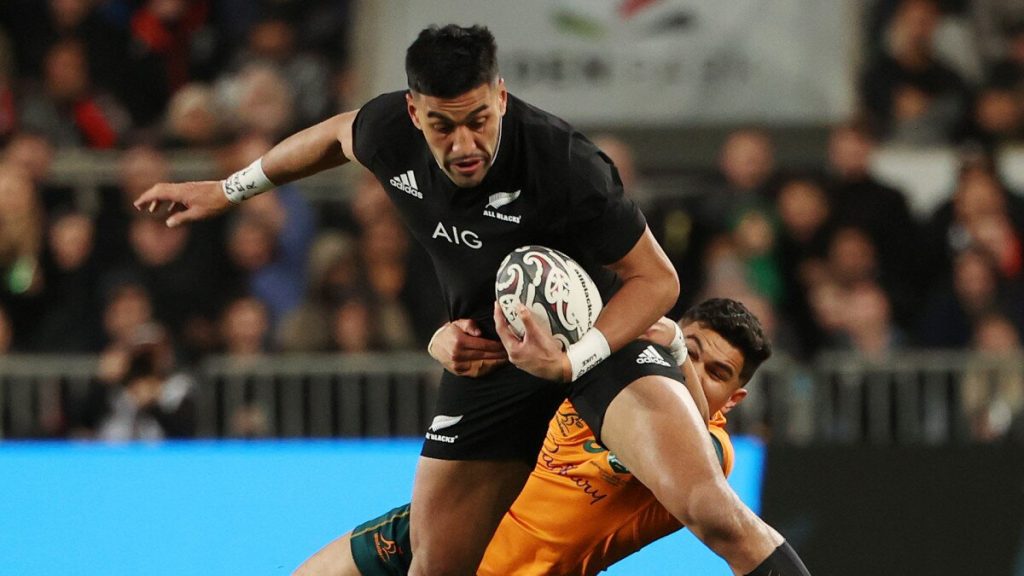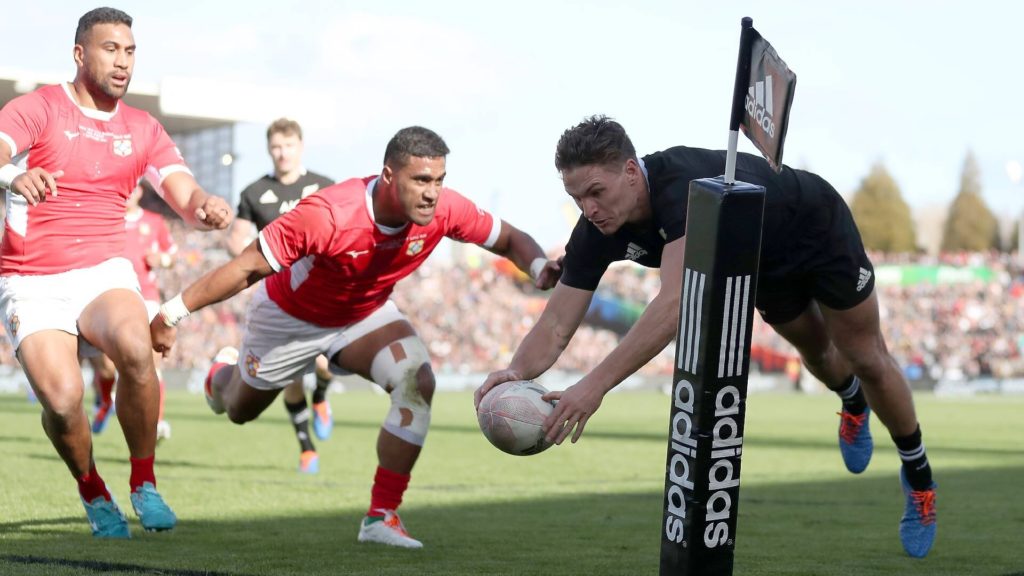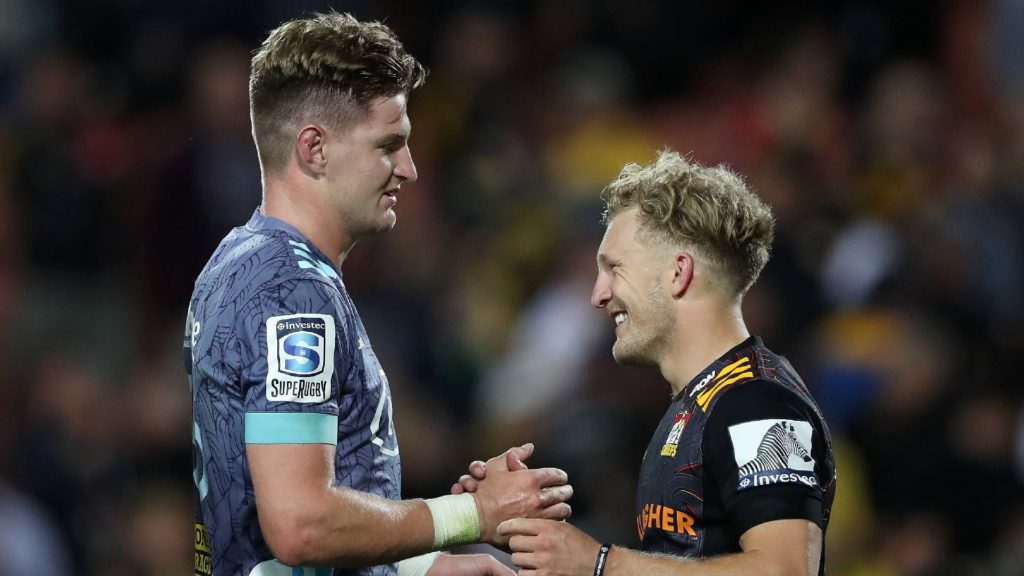After three tests against the Wallabies, a team who base their attack around pace and width, the All Blacks are preparing for a different challenge against the far more direct Argentines and South Africans, but the expectation that their back three spark and finish opportunities will remain the same.
It’s the All Blacks way to seek and exploit space via their fast men and while time and space are likely to be at a premium over the next four weeks given the defensive intensity the Pumas and Boks like to employ, both sides will have to be accurate with their kick-chase because nearly all of the All Black outside backs are in excellent form and all, bar none, enjoy counter-attacking from the back.
It has also presented head coach Ian Foster with some difficult selection choices – he described it as a good headache to have – after he again rolled the dice on his wings for the test against the Pumas on the Gold Coast on Sunday.
Crusaders’ pair George Bridge and Sevu Reece are the starting wings, with Jordie Barrett not surprisingly retaining his place at the back after the judicial hearing for his red card against Australia last weekend confirmed he would face no further sanction.
Rieko Ioane, who can cover wing and midfield, but who excelled in the No 11 jersey in Perth, has been named on the bench. Damian McKenzie again covers first-five and fullback from the bench and there is no room for Will Jordan, who kept his phenomenal try-scoring record going at Optus Stadium – he has scored in his last six tests.

Having all six players fiercely contesting three starting positions is healthy for the All Blacks because Foster admitted it’s unlikely he will select anyone to start in all five tests in Australia before the squad move on to the United States and Europe.
It is also rare. Bridge and Reece made their big moves back in 2019 when then-head coach Steve Hansen rolled the dice and named them to start against Australia at Eden Park after a lacklustre collective performance in Perth a week earlier, with Ioane and Ben Smith the casualties due to a lack of form.
Bridge and Reece carried that momentum into the World Cup but injuries for the former and a strategy of selecting Jordie Barrett on the right wing last year curtailed both men’s opportunities and even earlier in 2021, Bridge showed signs of rustiness after returning from a bout of appendicitis.
He appeared to lack a yard of pace in the test against Tonga but has since found it on the training field and he looked sharp after coming off the bench to finish off a break by TJ Perenara as the All Blacks swept the Wallabies last weekend.
We have looked at it a little holistically. Sevu clearly was one of our form backs in the Steinlager series. He’s played well in the early Bleds. We gave him a rest last week and now he’ll be ready to go. We’re seeing signs that George is really back in the form that we know he’s got so it’s really important he gets an opportunity to stake his claim.
Reece has been one of the All Blacks best attacking weapons this year and will be eager to make the most of his chance after not playing in Perth, while Ioane continues to go from strength to strength after a flat last couple of years.
He emulated his big brother Akira at times last weekend – the Australians seemed to panic every time he got the ball – but one of his best efforts was in getting back to stop the flying Tom Banks.
“It’s a good headache to have; having, for example, the likes of Rieko on the bench,” Foster said. “Obviously, he has the ability to cover both [wing and midfield] but he’s in great form at the moment.
“We have looked at it a little holistically. Sevu clearly was one of our form backs in the Steinlager series. He’s played well in the early Bleds. We gave him a rest last week and now he’ll be ready to go. We’re seeing signs that George is really back in the form that we know he’s got so it’s really important he gets an opportunity to stake his claim.”
What Foster means is that he must take a wide range of things into account when preparing over the next couple of weeks. After announcing his team, Foster and his squad were scheduled to fly across the country from Perth to the Gold Coast – two days before facing the Pumas – and there is only a six-day turnaround before the next game against the same opposition in Brisbane.

With such riches on the wings, it appears Jordie Barrett’s days of playing there are numbered, and if there was one criticism of Foster’s selections last year, it was his propensity to keep selecting Barrett on the right despite him being a specialist fullback. Barrett has had limited opportunities so far this year, with McKenzie the preferred second playmaker for the three-test Steinlager series against Tonga and Fiji as well as the two Bledisloe Cup tests at Eden Park. Barrett started at fullback only against Fiji in Dunedin.
There is also a sense that Jordie connects well with brother Beauden, and with Beauden likely to start three of the next four tests at No 10 as Richie Mo’unga stays in New Zealand for family reasons, it’s a combination that’s likely to continue for a while yet.
“I thought he started that test well,” Foster said of Jordie’s performance in Perth before he was shown a red card for catching Marika Koroibete in the face with his left boot when leaping for a high ball.
“This is a chance for that to continue. We’re going to have to be smart about how we manage our 10 situation. We haven’t got a lot of specialist 10s with us with just Damian and Beaudy, so in some cases, it’s about managing that to get through the next couple of tests well.
The fullback spot is an intriguing one, because there is also a sense of pragmatism at play with the selection of the much larger Jordie Barrett at the back for the more physical threats of the Pumas and Boks, who will also kick much more than the Wallabies did.
“There are little combination and a few variables there [to take into account] that means Jordie is the right person but he’s excited and clearly it’s a pretty stressful time going through a judicial process. You never know quite know what’s going to go on but he’s a relieved man and ready to go.”
That applies to Bridge too, to a large extent.
“He’s fast now,” Foster said. “He’s quick and strong. In July, I could just tell he was probably a little bit more frustrated with his own ability to do what he wants to do – it wasn’t so much about selection. He’s got high standards for himself. It’s just a natural curve. He’s been out for a long time, he’s come back and now he’s sharp and fast and contributing.
“We’ve added him to our strategy group because he’s a sharp brain in that back three. He’s in a good place. He’s seen the form of the other guys but he’s got his own internal drivers which are pretty powerful.”
It’s close, but Rieko Ioane must be considered the All Blacks’ best current left wing, with Reece edging the right wing spot ahead of Jordan, who can also play fullback.
The fullback spot is an intriguing one, because there is also a sense of pragmatism at play with the selection of the much larger Jordie Barrett at the back for the more physical threats of the Pumas and Boks, who will also kick much more than the Wallabies did.

Despite being one of the smallest players on the pitch, McKenzie, around 85kg, has generally thrived on the test scene after making his debut at the end of 2016, but there were indications he was targeted by the Wallabies in the second Eden Park test this year and he was knocked around in the opening quarter, his game suffering a little as a result.
The Pumas and Boks will find it harder to do that to Barrett, who is 1.96m tall and nearly 100kg.
The other side of the equation is that McKenzie is better than most at exploiting the space left by very big, and therefore usually slightly less agile, players. With the world champion Boks looming, McKenzie’s selection at the back could very much be a case of high risk, high reward. Few All Blacks fans will forget the way McKenzie jinked his way through the defensive line in Cape Town for a late try which helped his side beat the Boks 25-24 in Cape Town in 2017.
Those of his many supporters around the world, and those who were raised on the premise that the game is meant for players of all shapes and sizes, are likely to hope Foster rolls the dice.
“When you’re afraid, you start second-guessing yourself,” McKenzie said in an interview four years ago. “It’s a great challenge being small. When you’re playing against people twice your size it’s an awesome challenge. You need to embrace it.”


Comments
Join free and tell us what you really think!
Sign up for free